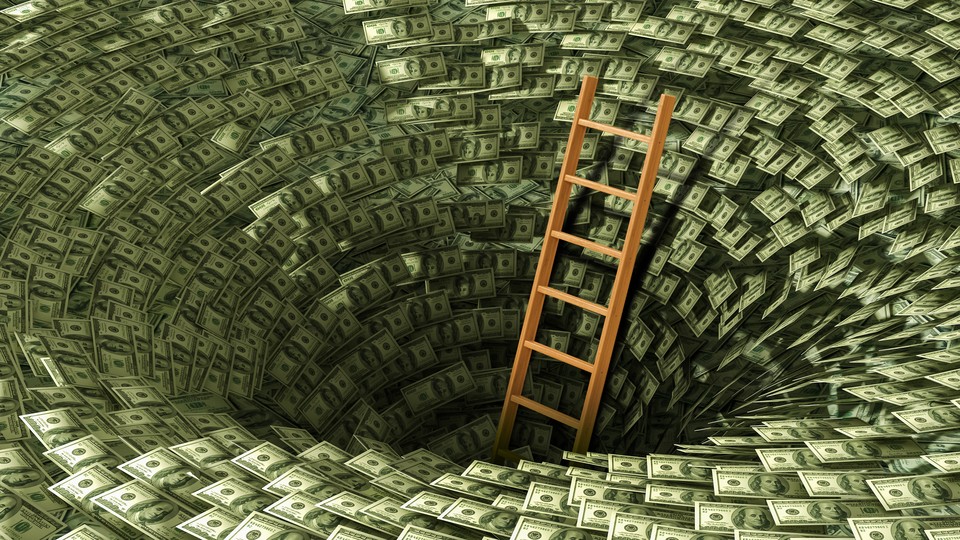The Radical Potential of Bankruptcy
8 min read
Alexza, a Midwest native, struggled with credit-card debt for 10 years, working multiple jobs—as a nanny, bartender, and distillery tour guide—just to meet the minimum payments. Collection agencies called her constantly. She stopped answering, but that wasn’t enough to escape her financial anxiety. She entered an inpatient therapy program in large part because of the stress, which compounded her debts further. (Alexza requested to be referred to by only her first name in order to speak candidly about her finances.)
She had considered bankruptcy, but she was afraid of what it would say about her. “You kind of feel like a failure,” she told me. The cost of filing—in her case, about $1,800 to cover legal fees—was also prohibitive for someone without any savings. But in September 2021, while working at a coffee shop, she decided, “I can’t afford to continue to just barely tread water.” She borrowed the money from a friend and met with a lawyer. Less than two weeks after she filed, the calls from collection agencies stopped. By January, she had erased nearly $20,000 of medical and credit-card debt.
Debt has long plagued many Americans like Alexza. Today, people in the U.S. carry more debt than they did a few decades ago. Household debt tripled between 1950 and 2022; as of 2020, 14 percent of Americans had so much debt that it outweighed the value of their assets. In this context, you might expect more people to reach for the kind of financial fresh start that bankruptcy can offer. Yet last year, fewer than 0.2 percent of American adults filed. Of course, not everyone in debt would benefit from bankruptcy—but a lot of people might. At a time when so many Americans are struggling, why aren’t more people taking that path to a second chance?
Until the early 19th century, Americans in debt had few mechanisms by which to dig themselves out. But beginning in the 1810s and 1820s, the political scientists Emily Zackin and Chloe N. Thurston write in The Political Development of American Debt Relief, whitefarmers in the southern and Plains states, who sometimes had to take out loans if their crops failed, began demanding that their political representatives do something to help. Thanks in part to those efforts, legislators began working to create a process by which people could take their creditors to court, with the goal of erasing what they owed; the debtors would be free to start over. (The process was mostly concerned with helping farmers in debt keep their property; it did little for Black sharecroppers, who didn’t own any land to begin with.)
The first federal voluntary bankruptcy law was passed in 1841. It was repealed two years later but reintroduced and expanded in 1867. As one senator who supported the 1867 expansion put it, all the law proposed was that anyone should be able to “escape from [their debts] and be again a man.” That idea was radical: It turned the U.S. into one of the most debtor-friendly countries on earth. Within three years of the American law’s reintroduction, nearly 43,000 debtors had cleared what they owed.
Today, U.S. bankruptcy law looks a lot different. American laws remain more forgiving than those in many other wealthy countries, such as Australia and Austria. But over the past several decades, financial-industry groups in the U.S. have pushed legislators to amend the bankruptcy system in a way that prioritizes creditors over debtors. And with each legal update, “it just gets harder and harder on consumers,” Robert H. Scott III, an economics professor at Monmouth University, told me.
In the late 1990s and early 2000s, bankruptcy was more common than it is now, and Americans were successfully canceling $4 billion per year in credit-card debt. But then credit-card lobbyists, worried about all of that lost revenue, began promoting the notion that certain debtors were abusing the system and driving up the cost of credit for everyone. (“What Do Bankruptcies Cost American Families?” one of their newspaper ads asked.) They argued that mass bankruptcies hurt the economy. So, however, does failing to help debtors: Debt is one of the greatest drivers of wealth inequality. Plus, many scholars contend that debtor-friendly bankruptcy laws foster entrepreneurship. But the creditor argument won out, and after much pushing, legislators passed the inelegantly named 2005 Bankruptcy Abuse Prevention and Consumer Protection Act. Since then, filing has become riskier, more onerous, and more expensive.
To file, debtors owe an up-front fee that can exceed $1,000—a bizarre catch-22 for someone who can’t afford to pay their bills. The bankruptcy process can also affect your credit score. Although research on exactly what filing does to a score over time is limited, a bankruptcy can stay on your credit report for up to 10 years, potentially limiting your access to rental housing and bank loans. Depending on where you live and what type of bankruptcy you file for, you might also be more likely to have to give up your home or your car to repay your debts. People filing in some states are more fortunate. In states like Rhode Island, which has a generous $12,000 motor-vehicle exemption, the risk of losing what might be your only way to commute to work is low. Alexza, for instance, was able to keep her old car. Texas and Florida homeowners are also lucky, as their houses are essentially protected from creditors. But people living in places with less generous protections may have to accept bigger losses.
The choice of whether to file gets more complicated when you factor in the different kinds of bankruptcy. While bankruptcy has many permutations, the two most common types for individuals are Chapter 7 and Chapter 13. Chapter 7, which Alexza filed for, erases most eligible debts but also demands that you give up any possessions over a certain value, with a few exceptions. For the poorest Americans, it’s a natural choice; 95 percent of people who file for Chapter 7 keep everything they own, and 96 percent have their debts discharged.
Chapter 13, by contrast, is essentially a long-term repayment plan. It comes with one major benefit—you can keep your assets—but it’s overall much less forgiving. If you miss payments, your whole case could be dismissed, leaving you solely responsible for paying off all of your debts once again. As Zackin and Thurston write intheir history of debt relief, Chapter 13 was created in the 1930s not to protect debtors, but as a way to funnel money back to American business owners who worried that bankruptcies were costing them. One contemporaneous study found that few debtors could keep up with payments; today, only about half of people who file for Chapter 13 ultimately become debt free, and some filers wind up in worse financial shape than when they started the process.
However, the legal system pushes a lot of poor people who don’t own much toward Chapter 13. Some of the pressure is structural, as traffic tickets and other court fees, which are disproportionately levied on the poor, can be forgiven only through Chapter 13. But bias in legal representation also plays a role: A study published by the American Bankruptcy Institute Law Review found that when advising debtors with identical financial situations, lawyers were more likely to recommend Chapter 7 to white clients and Chapter 13 to Black ones.
In various other ways, bankruptcy does not serve Americans equally. The typical filer is more likely to be middle income, even though low-income Americans have the most debt relative to their earnings—suggesting that the system may not be reaching them. This may be in part because many of the broadest exemptions are targeted at those who already own significant assets. Many states allow homeowners who file Chapter 7 to keep their house if it’s below a certain value, but renters don’t necessarily get to save possessions that most likely cost a lot less than a home. Meanwhile, many debts faced by formerly incarcerated people, such as restitution debts and parole fees, cannot be removed during Chapter 7 or Chapter 13. And student loans didn’t become easier to discharge in bankruptcy court until 2022.
The inequities don’t end there. Even as bankruptcy has failed to reach many of the Americans who need it most, it has morphed into an escape hatch for the wealthy. Chapter 11 was designed specifically for wealthy people and corporations. It lets them pay back creditors over the long term, sometimes in part at a lower interest rate, while their companies operate as usual, in the name of protecting their employees’ jobs. Rudy Giuliani, Francis Ford Coppola, and Donald Trump have filed for Chapter 11—in Trump’s case, six times. Though the process is expensive and complicated, according to the scholar Melissa Jacoby, it is actually much friendlier than the bankruptcies the rest of us use.
Leaving aside the difficulty of filing, the perhaps more significant barrier to choosing bankruptcy, for many Americans, is the stigma. Some scholars have likened the process to a kind of public penance. During it, a court scrutinizes your finances and choices. And because many people consider debt to be an individual failing, those going through bankruptcy can feel humiliated—even though, in many cases, debt is more properly seen “as a collective misfortune,” Daniel Platt, a legal-studies professor at the University of Illinois at Springfield, told me. In the 19th century, members of the debtors’ movement understood that their struggles were shared. Glimmers of that mindset emerged after the 2008 financial crisis, when many people drew a direct line between corporate exploitation and individuals’ money troubles. But even in the absence of widespread economic catastrophe, when someone declares bankruptcy “there has been a failure,” Dalié Jiménez, a law professor at the University of California at Irvine, explained. “A lot of that failure is not on the person but on the system that has no other safety net for you.”
Of course, bankruptcy cannot save individuals from that systemic failure. Expunging your debts cannot, for instance, solve the problem of stagnating wages or rising housing costs. But for people like Alexza, it can offer some breathing room. One moment she couldn’t see a way out of her debts. Then, before she knew it, they were gone.

When you buy a book using a link on this page, we receive a commission. Thank you for supportingThe Atlantic.



